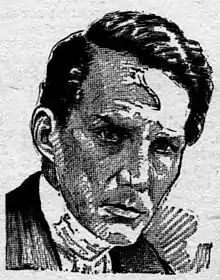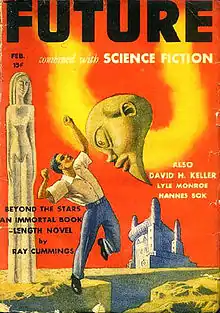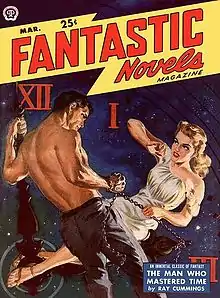Ray Cummings
Ray Cummings (born Raymond King Cummings) (August 30, 1887 – January 23, 1957) was an American author of science fiction literature and comic books.

Early life


Cummings was born in New York City in 1887. He worked with Thomas Edison as a personal assistant and technical writer from 1914 to 1919.
Literary career
Cummings is identified as one of the "founding fathers" of the science fiction genre.[1] His most highly regarded fictional work was the novel The Girl in the Golden Atom published in 1922, which was a consolidation of a short story by the same name published in 1919 (where Cummings combined the idea of Fitz James O'Brien's The Diamond Lens with H. G. Wells's The Time Machine)[2] and a sequel, The People of the Golden Atom, published in 1920.[3]
Before taking book form, several of Cummings's stories appeared serialized in pulp magazines. The first eight chapters of his The Girl in the Golden Atom appeared in All-Story Magazine on March 15, 1919.[4][5]
Ray Cummings wrote in "The Girl in the Golden Atom": "Time . . . is what keeps everything from happening at once",[6] a sentence repeated by scientists such as C. J. Overbeck,[7] and John Archibald Wheeler,[8][9] and often misattributed to the likes of Einstein or Feynman. Cummings repeated this sentence in several of his novellas. Sources focus on his earlier work, The Time Professor, published in 1921, as its earliest documented usage.[10]
Later work
During the 1940s, with his literary career in eclipse, Cummings anonymously scripted comic book stories for Timely Comics, the predecessor to Marvel Comics. He recycled the plot of The Girl in the Golden Atom for a two-part Captain America tale, Princess of the Atom (Captain America Comics #25 & 26). He also contributed stories to the Human Torch and Sub-Mariner, which his daughter Betty Cummings often penned.
Cummings died on January 22, 1957, at Mount Vernon, New York, of a cerebral hemorrhage.
Selected literary works
- The Girl in the Golden Atom, short story (1919)
- The People of the Golden Atom (1920)
- Moon Plot (Argosy c. 1920)
- The Girl in the Golden Atom, novel (1922)
- The Man Who Mastered Time (Argosy 1924)
- Brand New World (Argosy 1928)
- Snow Girl (Argosy 1929)
- The Shadow Girl (Argosy 1929)
- The Sea Girl (Argosy 1929)
- The Princess of the Atom (1929)
- Tama of the Light Country (Argosy 1930)
- Beyond the Vanishing Point, Astounding (March 1931)
- Brigands of the Moon (McClurg, 1931)
- Jungle Rebellion (Argosy 1931)
- Tama Princess of Mercury (Argosy 1931)
- Bandits of the Cylinder (Argosy 1931)
- Beyond the Stars, Future (February 1942)
References
- "GC Willick".
- "Two Early Works by Ray Cummings: "The Fire People" and "Around the Universe"". Cite magazine requires
|magazine=(help) - Bleiler, Everett F. (1990). Science-Fiction: The Early Years. https://archive.org/details/sciencefictionea0000blei/page/171. p. 171.CS1 maint: location (link)
- no title given
- Note,
In the novel version, the quote about time appears in [http://www.gutenberg.org/ebooks/21094 Chapter V
- Cummings, Raymond King (1922). The Girl in the Golden Atom. U of Nebraska Press. p. 46. ISBN 978-0-8032-6457-1. Retrieved 2011-04-09. Chapter 5.
- International, Rotary (Aug 1973). "The Rotarian". The Rotarian. Published by Rotary International: 47. ISSN 0035-838X. Retrieved 2011-04-09., What does a man possess? page 47
- Daintith, John (2008). Biographical Encyclopedia of Scientists (third ed.). CRC Press. p. 796. ISBN 978-1-4200-7271-6. Retrieved 2011-04-09., Page 796, quoting Wheeler from the American Journal of Physics, 1978
- Davies, Davies (1995). About time: Einstein's unfinished revolution. Simon & Schuster. p. 236. ISBN 0-671-79964-9. Retrieved 2011-04-09.
- Nahin, Paul J. (20 April 2001). Time Machines: Time Travel in Physics, Metaphysics, and Science Fiction. ISBN 9780387985718.
External links
- Science Fiction inventions of Ray Cummings
- Works by Ray Cummings at Project Gutenberg
- Works by Raymond King Cummings at Faded Page (Canada)
- Works by or about Ray Cummings at Internet Archive
- Works by Ray Cummings at LibriVox (public domain audiobooks)

- Ray Cummings at the Internet Speculative Fiction Database
